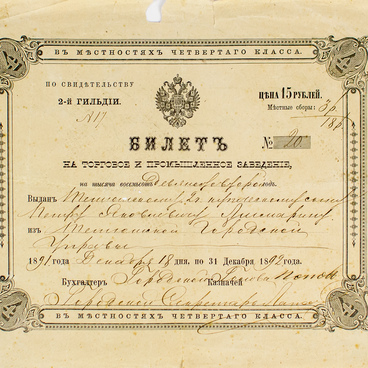The dish presented in the exhibition from the Gardner Porcelain Factory in Russia was intended for aspic — fish or meat — and roast game. It belonged to the family of Kondakovs, who were doctors from Tetyushi. It was given to the museum by Lilia, the wife of Valerian Kondakov, an Honored Doctor of the Russian Soviet Federated Socialist Republic and the Tatar Autonomous Soviet Socialist Republic, a citizen of honour of Tetyushi. He inherited the serving dish from his mother, Elena Kalsanova, came from a merchant family.
The Scottish merchant Franz Gardner founded the Gardner factory in 1766. It was located in the small village of Verbilki in the Dmitrov district of Moscow province.
Gardner invited his first craftsmen from the German town of Meissen. This town was famous for its porcelain. One of them was Johann Miller, who by that time had already lived for a long time in Russia and had also worked at the Imperial Porcelain Factory led by Dmitry Vinogradov.
The Gardner factory produced not only exclusive objects for the imperial palaces and homes of the highest nobility. The factory also set up mass production of porcelain dishes. It was highly valued in Russia. Many who could not afford imported Saxon porcelain willingly purchased domestic porcelain made in The Gardner factory.
Franz Gardner died in 1796. At that time, the factory was one of the best private porcelain factories in Russia. His wife took over the inheritance and soon production fell into disrepair. But later Gardner’s sons managed to bring the factory back to its former level.
In 1829, the factory received small gold medals at the first All-Russia Industrial Exhibition. In 1855, it received a special commendation from the emperor and the honorary right to place the image of the state double-headed eagle on its products. In the Russian Empire, such a stamp was the equivalent of a quality mark. The factory has repeatedly confirmed the right to use the image of the Russian coat of arms on its products. In 1856, the factory received the title “Supplier of His Imperial Majesty’s Court”.
For 126 years since the opening the factory was run by the descendants of Franz Gardner, including his grandsons Alexander, Peter and Nicholas and then Peter’s sons — Vladimir, Nicholas and Pavel. Finally, Elizaveta Nikolaevna, Pavel’s widow, sold the factory to manufacturer Matvey Kuznetsov in 1892. The factory survived the revolution and continues to operate today under the name “Gardner Manufactory in Verbilki”.
The Scottish merchant Franz Gardner founded the Gardner factory in 1766. It was located in the small village of Verbilki in the Dmitrov district of Moscow province.
Gardner invited his first craftsmen from the German town of Meissen. This town was famous for its porcelain. One of them was Johann Miller, who by that time had already lived for a long time in Russia and had also worked at the Imperial Porcelain Factory led by Dmitry Vinogradov.
The Gardner factory produced not only exclusive objects for the imperial palaces and homes of the highest nobility. The factory also set up mass production of porcelain dishes. It was highly valued in Russia. Many who could not afford imported Saxon porcelain willingly purchased domestic porcelain made in The Gardner factory.
Franz Gardner died in 1796. At that time, the factory was one of the best private porcelain factories in Russia. His wife took over the inheritance and soon production fell into disrepair. But later Gardner’s sons managed to bring the factory back to its former level.
In 1829, the factory received small gold medals at the first All-Russia Industrial Exhibition. In 1855, it received a special commendation from the emperor and the honorary right to place the image of the state double-headed eagle on its products. In the Russian Empire, such a stamp was the equivalent of a quality mark. The factory has repeatedly confirmed the right to use the image of the Russian coat of arms on its products. In 1856, the factory received the title “Supplier of His Imperial Majesty’s Court”.
For 126 years since the opening the factory was run by the descendants of Franz Gardner, including his grandsons Alexander, Peter and Nicholas and then Peter’s sons — Vladimir, Nicholas and Pavel. Finally, Elizaveta Nikolaevna, Pavel’s widow, sold the factory to manufacturer Matvey Kuznetsov in 1892. The factory survived the revolution and continues to operate today under the name “Gardner Manufactory in Verbilki”.



